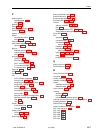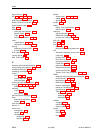
Index
IN-8
9123-A2-GB20-10
July 2000
right arrow key, 2-6
RIP, 1-4, 3-10, 3-62, 5-25
proprietary, 3-55
RJ45, Ethernet Port connector, C-7
RJ48C, COM Port connector, C-2
RJ48C network cable, C-2
RLB, 6-23
RMON
alarm and event defaults, B-15
Specific Traps, B-14
Traps, 3-56
user history collection, 1-6, 1-7
router
independence, 1-4, 3-17
setting up to receive RIP, 3-10
Routing
Information Protocol (RIP), 3-62
IP, table, 5-24
RTS, control lead, 5-6
running reports, 9-6
RXD, control lead, 5-6
S
Sampling, SLV Inband and Interval, 3-20
saving configuration options, 3-7
scheduled activations, 7-9
scheduling, activations, 7-8
screen
area, 2-5, 2-6
function keys area, 2-5
how to navigate, 2-6
scrolling through valid selections, 2-9
security, 1-4, 2-1, 2-2, 3-6, 4-1
SNMP NMS, options, 3-53
selecting
a field, 2-9
from a menu, 2-8
Self-Test Results messages, 5-13
Send
and monitor test pattern, 6-26
Pattern, 6-18
serial number, NAM, 5-2
Service, A
service level
management, 1-8
reports, 9-6
verification
configuring, 3-20
statistics, 5-28
Session
Access Level, 3-51, 4-5, 4-7
ending, 2-3
starting, 2-2
Set DE, 3-47
setting
Date & Time (system clock), 3-10
date and time, 3-10
setting up
auto-configuration, 3-11
SNMP trap managers, 3-53
so router can receive RIP, 3-10
SIG, LED, 5-5
SLA, 1-7, 1-8
SLM, 1-8
OpenLane, 7-1
performance monitoring feature set, 1-7
SLV
Activation Certificates, how to order, 7-4
configuring, 3-20
Delivery Ratio, 3-20
DLCI Down on Timeout, 3-20
managing activations, 7-6
Packet Size, 3-21
performance statistics, 5-28
Sample Interval (secs), 3-20
Synchronization Role, 3-21
Timeout, Error Event Threshold, 3-20, 3-21
SNMP
assigning community names/access levels, 4-9
limiting access, 4-8, 4-10
Management, 3-49, 4-8
NMS security, options, 3-53
Number of Managers, 3-53
setting up Trap Managers, 3-53
trap event log, 5-39, 6-11
Traps, 3-54
downloading, B-2
standards, B-6
supported, 6-2
software
changing, 5-43
downloading, 5-40
revision, NAM, 5-2
Source
DLCI, 3-40
EDLCI, 3-40
Link, 3-40


















